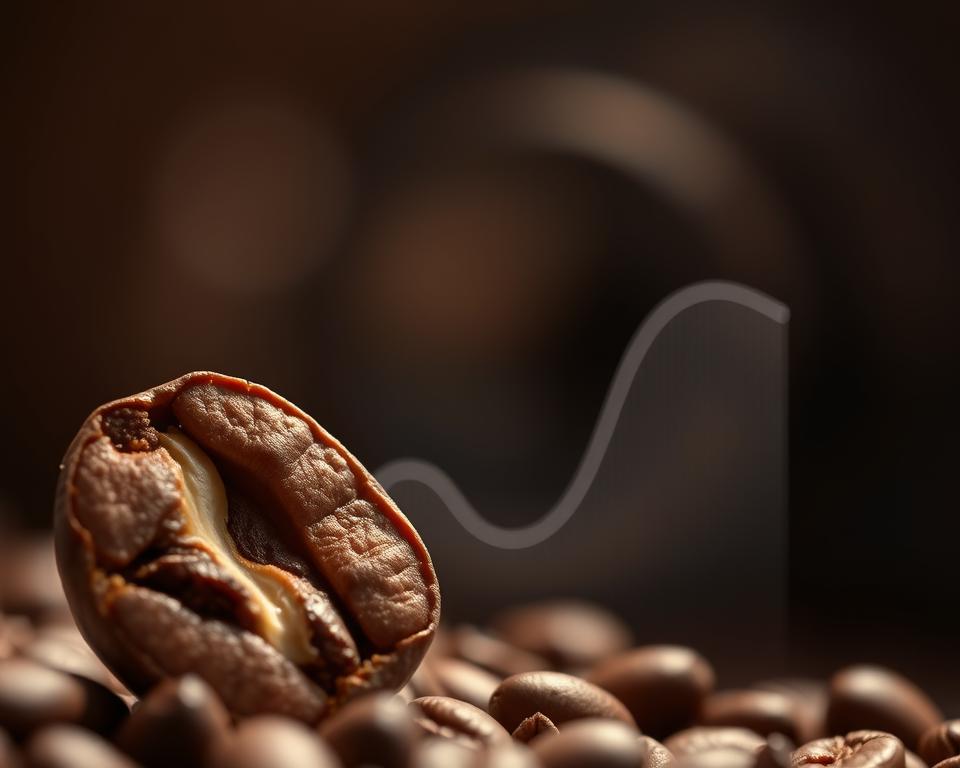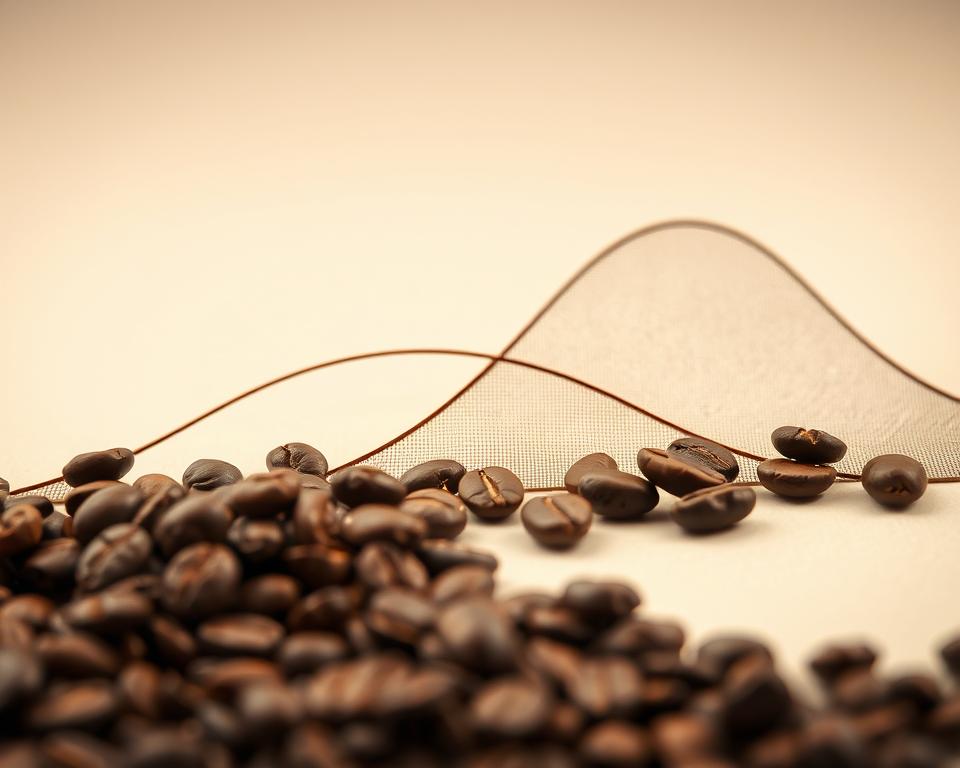Coffee roast curves are vital in coffee roasting, showing the beans’ temperature during roasting. They help identify the best roast development and flavor extraction. This is key to achieving exceptional coffee flavor. It requires understanding roasting techniques and analyzing roast profiles to refine your skills.
Experts say the ideal roast time depends on batch size and burner output. There’s no single right roast time. This underscores the need to grasp coffee roast curves and apply roasting techniques for the perfect flavor. Mastering these curves can elevate your coffee roasting, creating top-notch coffee for coffee connoisseurs.
Introduction to Coffee Roast Curves
Coffee roast curves are fundamental in coffee roasting, crucial for any roaster. They help spot areas for improvement and optimize the roasting process. This means using tools like data-logging software to monitor and control the roasting. It ensures you get the perfect roast every time.
Key Takeaways
- Mastering coffee roast curves is essential for achieving exceptional flavor in your coffee
- Coffee roast curves provide a graphical representation of the temperature of the coffee beans during the roasting process
- Understanding coffee roasting techniques and conducting roast profile analysis is crucial for perfecting your craft
- Optimal roast duration is dependent on the ratio of batch size to burner output
- Mastering coffee roast curves can help you produce high-quality coffee that meets the expectations of discerning coffee lovers
- Coffee roasting techniques and roast profile analysis are critical components of coffee roast curves
What Are Coffee Roast Curves?
Coffee roast curves are vital in coffee roasting, showing the beans’ temperature during roasting. They are key for optimal roast development, impacting coffee flavor extraction and quality. The curve varies based on batch size and burner output, affecting “Roast Time”.
The roast degree determination is influenced by roasting style and development level. Filter roasts are lighter, emphasizing brightness and fruit notes. Espresso roasts are darker, offering a full body and rich mouthfeel. Grasping roasting basics and curve importance is crucial for quality coffee.
The roasting process involves conduction, convection, and radiance heat transfer. Roasters like the Loring Falcon S15 offer unmatched control, allowing for quick heat adjustments. Mastering coffee roast curves enables roasters to balance flavor and quality, creating an outstanding coffee experience.
The Science Behind Roast Curves
Coffee roasting is a complex process, involving chemical reactions like the Maillard reaction and caramelization. To get the best flavor, it’s key to monitor the roasting process monitoring and tweak the roast curve. The rate of rise (RoR) shows how fast the coffee bean’s temperature goes up during roasting. This is critical for coffee roast evaluation.
Understanding roast curve interpretation is crucial for coffee roasters. The Maillard reaction kicks in around 302°F (150°C) and speeds up with higher temperatures. Caramelization happens at over 356°F (180°C). By managing the roast curve, roasters can enhance the coffee’s flavors and aromas. For deeper insights into coffee roasting’s science, check out this article to explore the chemical reactions during roasting.
Heat Transfer and Chemical Reactions
Heat transfer is key, happening through conduction, convection, and radiation. It shapes the roast curve. The Maillard reaction, a chemical process between amino acids and sugars, happens when beans are heated. It creates new flavor compounds.
Flavor Development and Roast Curve Interpretation
Knowing the science behind roast curves lets roasters fine-tune the roasting to get the flavor they want. A shorter development phase brings out coffee’s acidity. A longer phase adds caramelized notes and lowers acidity. Proper roasting process monitoring and coffee roast evaluation are vital for perfect flavor and roast curve interpretation.
Different Types of Coffee Roast Curves
Coffee roast curves are vital in coffee roasting, shaping the flavor of the final product. They transform green coffee beans into the aromatic, flavorful beans we love. Coffee roasting techniques are key in this transformation, influencing the flavor profile. Understanding the roast profile analysis is crucial to grasp each curve’s characteristics.
There are various coffee roast curves, each with its own unique flavor profiles. Coffee roast curves fall into two main categories: light and dark roasts. Light roasts are more acidic and fruity, while dark roasts are richer and more bitter. The roast profile analysis is essential to find the perfect roast curve for each coffee bean.
Popular roast curves include City Roast and Full City Roast. City Roast is lighter, while Full City Roast is darker. The coffee roasting techniques used impact the final flavor. For instance, Nordic roasting emphasizes very light roasts to highlight origin flavors.
For coffee lovers, understanding different roast curves and their flavors is key. By analyzing roast profiles and employing various roasting techniques, roasters can craft unique, delicious flavors. Whether you enjoy light, fruity or rich, bitter flavors, there’s a roast curve for you.
Factors Influencing Roast Curves
Several factors play a crucial role in achieving optimal roast development. The origin and species of coffee beans, along with the roasting equipment and techniques, significantly impact the roast curve. For example, beans from different regions may have unique flavor profiles and densities. These differences can alter the roast curve.
The type of roasting equipment and techniques used also matters. They influence the heat transfer and flavor extraction levels. This, in turn, affects the roast degree determination.
Understanding the ratio of batch size to burner output is key in roast curve development. An expert advises, “I don’t recommend a specific roast duration; instead, I always teach that optimal roast duration is dependent on the ratio of batch size to burner output.” This emphasizes the need to balance these factors for the best coffee flavor extraction.
By grasping these factors and their interactions, roasters can improve their techniques. This leads to producing high-quality coffee with optimal roast development.

- Bean origin and species
- Roasting equipment and techniques
- Batch size and burner output
- Coffee bean density and moisture content
By carefully considering these factors and adjusting roasting techniques, coffee roasters can achieve optimal roast development and flavor extraction. This results in a higher-quality cup of coffee.
The Phases of the Coffee Roasting Process
Coffee roasting is a complex process with several phases, each with unique characteristics. Effective roasting process monitoring is key to perfecting the coffee beans. The process starts with the drying phase, where beans lose moisture and undergo physical changes.
As beans move through the roasting process, they reach the first crack. This is a significant stage, marking the start of roast development. Experts say, “The First Crack is a significant stage in coffee roasting when the beans release moisture and emit cracking sounds.” This stage is crucial for coffee roast evaluation, as it affects the flavor and aroma of the final product.
Understanding the phases of coffee roasting is vital for roast curve interpretation. The drying phase lasts between 5-6 minutes, followed by the Maillard phase, lasting 3-4 minutes. The first crack occurs between 6-7 minutes, starting the development phase.
Mastering the phases of coffee roasting and monitoring the process allows for high-quality coffee production. Whether it’s a light, medium, or dark roast, success depends on careful roasting process monitoring and attention to detail.
Analyzing Roast Curves: What to Look For
Understanding the relationship between time and temperature in coffee roast curves is key. Analyzing the roast curve reveals the best roast development and flavor extraction. Coffee roasting techniques are vital, as they influence the coffee’s final taste and aroma.
Monitoring bean temperature (BT) and environmental temperature (MET) during roasting is crucial. It helps spot any roast defects or inconsistencies. Experts liken roast profiles to roadmaps, guiding beans through roasting. By examining the roast curve, you can tweak your coffee roasting techniques to get the perfect flavor and aroma.
Key factors in analyzing roast curves include:
- Rate of Rise (RoR): shows how fast the bean temperature rises
- Turning point: when the green bean and probe temperatures equalize
- First crack: signals the shift from browning to development stages

By closely examining the roast curve and adjusting your coffee roast curves and roast profile analysis methods, you can achieve consistent, high-quality results. This is critical for commercial roasters, allowing them to refine their roast profiles and maintain quality.
Adjusting Roast Curves for Desired Flavor
To perfect your coffee, tweaking the roast curve is essential. This means managing heat and exploring various roast profiles. It’s all about achieving optimal roast development and coffee flavor extraction. This way, you can pinpoint the perfect roast degree determination for your beans.
Experts take a broad view of roasting, looking at time, temperature, air, and ratios. For instance, Nordic light roasts and Scott Rao’s high-start, slow-rise method are favored for their sweetness. You can tweak roasting by adjusting temperatures, fan speeds, and phase ratios.
- Bean type and processing method
- Roasting equipment and techniques
- Time and temperature relationships
- Flavor and aroma notes
By fine-tuning these elements, you can craft a roast curve that highlights your coffee’s unique traits. This leads to the flavor you’ve always wanted.
Tools for Monitoring Coffee Roast Curves
Monitoring coffee roast curves is key for optimal flavor and quality. Modern tech has made coffee roast evaluation more efficient. It involves tracking temperatures inside and around the roasting drum.
The main purpose of a roast curve is to ensure batch consistency in quality control (QC) processes. Road curve interpretation helps identify machine or venting problems. It also aids in comparing seasons, origins, varietals, processing methods, and roasting equipment.
Tools for monitoring roast curves include software and manual methods. For instance, the RoastSee C1 Coffee Roast Analyzer uses MIS+NIR technology for precise measurements. It boasts a measurement accuracy of ±1 and a range of 0-150.
Datalogging in coffee roasting tracks temperatures in and around the drum. This data helps analyze the roast curve and refine the roasting process. By employing these tools, coffee roasters enhance quality and consistency. Road curve interpretation becomes essential in this process.
Common Mistakes to Avoid in Roasting
Coffee roasting is an art form that offers endless possibilities for flavor exploration. It’s crucial to recognize common mistakes that can impact the quality of our roast. Research shows that 70% of home roasters face roast defects due to not researching their green coffee beans. This highlights the importance of understanding our beans before roasting.
Monitoring roast progress is key in coffee roasting techniques. Inadequate monitoring can lead to inconsistent roast development, resulting in a subpar flavor profile. By incorporating roast profile analysis into our roasting routine, we can better understand the nuances of coffee roast curves. This allows us to make adjustments to achieve the perfect roast.
- Preheat your equipment before starting the roasting process to prevent underdeveloped beans
- Regularly clean your equipment to prevent fire hazards and old coffee oils from impacting flavor
- Monitor temperature and humidity levels to adjust your roasting time and technique
By being mindful of these factors and incorporating coffee roast curves and roast profile analysis into our roasting routine, we can refine our coffee roasting techniques. This allows us to produce high-quality roasts that showcase the unique characteristics of our beans.
Conclusion: Perfecting Your Coffee Roast Curves
Mastering coffee roast curves is a continuous journey, akin to any craft that demands dedication and a willingness to experiment. Throughout this guide, you’ve discovered that the essence of perfecting roast profiles is embracing optimal roast development. It’s about continuously seeking ways to extract the finest coffee flavors.
The path in coffee roasting is endless, with endless opportunities to refine your roast degree determination and uncover new flavors. By remaining curious and open to new techniques, you’ll open doors to a vast array of possibilities in your coffee creations.
The art of coffee roasting is a blend of science and personal touch. Keep learning, experimenting, and refining your methods. With each roast, you’ll gather invaluable insights that will help you craft the perfect cup of coffee. Start this exciting journey, and let your passion for coffee roasting lead you to new heights of flavor and enjoyment.
FAQ
What are coffee roast curves?
Why are roast curves important in coffee roasting?
What are the different types of coffee roast curves?
What factors influence the coffee roast curve?
What are the key phases of the coffee roasting process?
How can I analyze and interpret coffee roast curves?
How can I adjust the roast curve to achieve the desired flavor profile?
What tools are available for monitoring coffee roast curves?
What are the common mistakes to avoid when roasting coffee?

Tina Avila is a writer at WyNeeds, where she delves into the rich and diverse world of coffee. With a passion for flavors and brewing techniques, she brings insightful articles covering everything from coffee culture and bean origins to expert tips on making the perfect cup. Her goal is to inspire and educate coffee enthusiasts, helping them enhance their appreciation for every sip.

